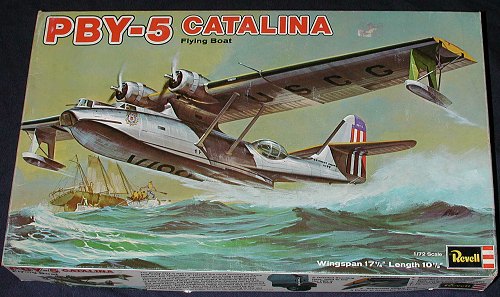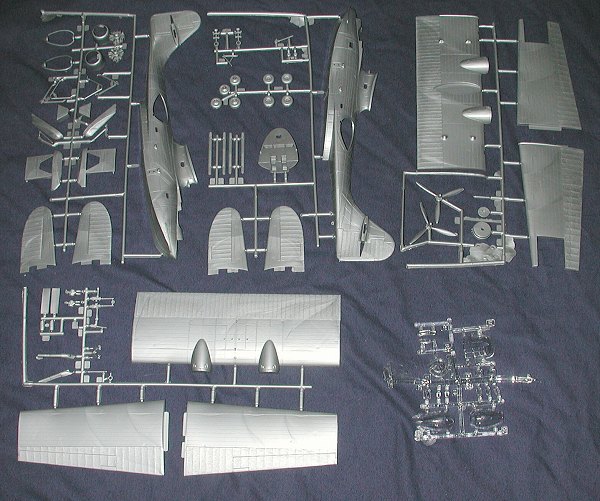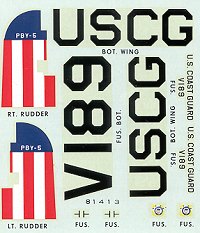
|
KIT: |
Revell 1/72 PBY-5 |
|
KIT # |
H-277 |
|
PRICE: |
$2.50 in 1971 |
|
DECALS: |
One option |
|
REVIEWER: |
Scott Van Aken |
|
NOTES: |

|
HISTORY |
Using new structural techniques, as well as practical
experience gained by the Navy from its first monoplane patrol boats, the
Consolidated PBY "Catalina" was designed to replace the P3M and P2Y
seaplanes. Initial models produced in l937 were strictly seaplanes
limited to waterborne takeoffs and landings with retractable outer wing
floats. If repairs were required on shore, beaching gear was floated out
and attached to a buoyed aircraft to permit it be towed up a ramp for
necessary maintenance. In November l939 Consolidated flew the first of
its amphibian designs that incorporated retractable, tricycle landing
gear to give them greater flexibility as a warplane.
In May l94l, a lend-lease PBY flown by a U.S. Navy pilot on duty as an
instructor with the RAF, is credited with locating the German
battleship Bismarck to be sunk the following day by a British
battleship/cruiser force. It was also a PBY that made the only attack on
a Japanese ship when it bombed a midget submarine on 7 December l94l, and
later spotted the Japanese invasion and carrier strike forces during the
Battle of Midway in June l942. During World War II, the "Catalinas"
performed a variety of essential duties, including long-range scouting
and antisubmarine patrols, convoy escorts, SAR (search and rescue) and
torpedo/bombing attack operations. It was in the latter functions that
the PBY established its greatest legacy by sinking more enemy shipping
than any other single type of aircraft during World War II. One squadron
in particular (the Black Cats) with aircraft painted black for night
operations only, were credited with sinking hundreds of tons of enemy
shipping. Two squadrons (VP-63 and VP-9l) were equipped with magnetic
detection gear in order to locate submerged submarines. Retro-bombs were
also installed which, when fired backwards at a velocity equal to the
speed of the aircraft, dropped straight down upon a target being
over-flown by the aircraft. The aircraft was also heavily utilized by the
US Coast Guard whose war-time job switched from stopping smugglers to
sinking submarines.
The last of the Navy's PBYs were retired in l957. Many of the aircraft
are still in active use today such as for forest fire operations in which
they land on lakes and scoop up water in special internal tanks to be
dropped on hot spots.
|
THE KIT |

Though the date on the instructions is 1971, this
kit is actually older than that, dating from the 1960s. Detailing is all
one could expect from kits of this era when rivets meant detail. The
aircraft not only has lots of them, and they are nicely done at that, but
it also has a fairly good representation of the fabric surfaces of this
aircraft. Like many of the models of its day, this one does have operating features, though they are
limited to things like rotating props, movable nose turret, and
retractable floats. The kit also comes with beaching gear. There is
little in the way of cabin detail so you won't see much through those
large side blisters. The cockpit consists of a floor, two pilots and two
control sticks. The transparencies are not bad at all for this era,
though a tad on the thick side.
models of its day, this one does have operating features, though they are
limited to things like rotating props, movable nose turret, and
retractable floats. The kit also comes with beaching gear. There is
little in the way of cabin detail so you won't see much through those
large side blisters. The cockpit consists of a floor, two pilots and two
control sticks. The transparencies are not bad at all for this era,
though a tad on the thick side.
Instructions are a combination of drawings and a written construction sequence. The colors needed are provided in the construction drawings, though only generic colors are provided. There is no separate camo/decal sheet as colors for the exterior and decal placement are provided throughout the construction sequences. This was an era when most builders didn't fill seams or worry about them, so 'paint as you go' was the norm. The decals are for an overall aluminum aircraft with yellow upper wings and stabilizers. They are well printed and the example in my kit are in superb condition, considering their age.
|
CONCLUSIONS |
Though superceded for most builders by the very nice Academy PBY series, this one is still highly sought by collectors because of its markings. Were one to build it, it would still make into a very nice model. The other various boxings of the Revell PBY are relatively easy to find at swap meets, where I found this one.
If you would like your product reviewed fairly and quickly by a site that has over 250,000 visitors a month, please contact me or see other details in the Note to Contributors.